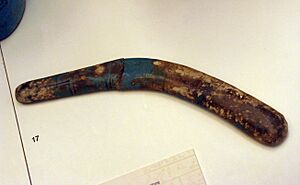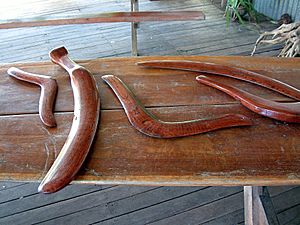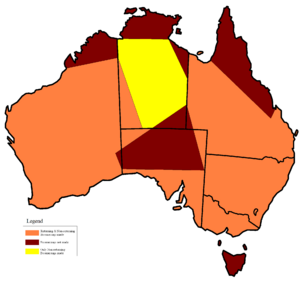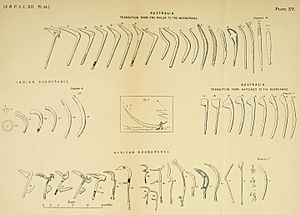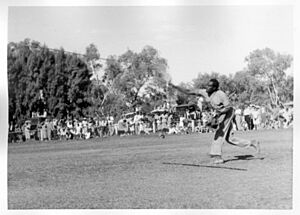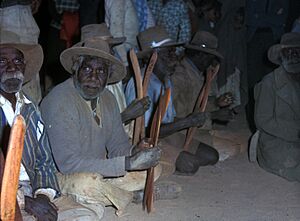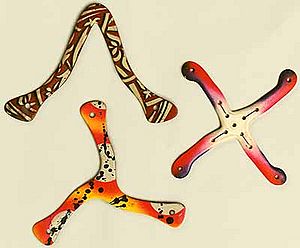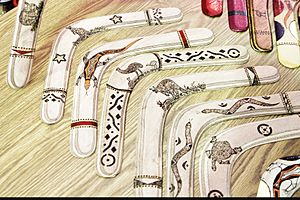Boomerang facts for kids
A boomerang is a special tool that you throw. It's shaped like a wing (an airfoil) and spins as it flies. Some boomerangs are designed to fly back to the person who threw them! The word "boomerang" comes from an Aboriginal Australian language spoken near Sydney.
Originally, the word only meant objects that came back. But today, people also use "non-returning boomerang" for throwing sticks. Many different kinds of boomerangs were used by Aboriginal Australians for hunting. They had many names for these tools before Europeans arrived. The oldest Aboriginal boomerang ever found is about 12,000 years old. It was discovered in South Australia and is now in a museum. Boomerangs have been used for hunting, sports, and fun. They come in many shapes and sizes for different uses. Ancient boomerangs have also been found in Egypt, the Americas, and Europe. We don't know if these old ones could return.
Contents
History of Boomerangs
For a long time, boomerangs were used for many things. They were hunting weapons, musical instruments, clubs for fighting, and even tools to start fires. Some were used as decoys to hunt waterfowl. Others were just toys for fun. The smallest boomerangs can be less than 10 cm (3.9 in) long. The largest can be over 180 cm (71 in) (about 6 feet) long!
Pictures of boomerangs being thrown at animals, like kangaroos, are found in very old rock art. This art is in the Kimberley region of Australia. It might be as old as 50,000 years! The oldest boomerang found in Europe was in a cave in Poland in 1985. It is about 40,000 years old. The oldest Australian Aboriginal boomerang was found in 1973. It was in a swamp in South Australia and is about 12,000 years old. This boomerang is now in the South Australian Museum in Adelaide.
A history teacher named Tony Butz said that returning boomerangs were not known everywhere in Australia. About 60% of Aboriginal peoples used both returning boomerangs and non-returning hunting sticks. They had different words for each. About 10% only used non-returning sticks. The rest did not use either. Pictures of boomerangs are also found in rock art in West Papua. These pictures are from a time when sea levels were lower. This meant people could travel more easily between Papua and Australia.
Even though boomerangs are often linked to Australia, similar weapons have been found in other places. These include ancient Europe, Egypt, and North America. Ancient Egyptians, Native Americans in California and Arizona, and people in South India used non-returning weapons. They used them to hunt birds and rabbits. An old study from 1883 mentioned Egyptian and African examples. But these were non-returning tools.
Hunting sticks found in Europe were part of the weapons used in the Stone Age. A boomerang-like weapon was found in Obłazowa Cave in Poland. It was made from a mammoth's tusk. Scientists believe it is about 40,000 years old. This makes it the oldest certain find of this type of weapon. In the Netherlands, boomerangs (called cateia) from the first century BC have been found. Even King Tutankhamun of Egypt had a collection of boomerangs!
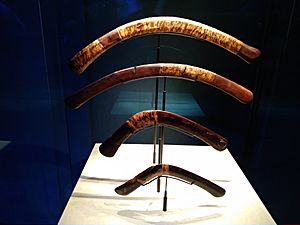
No one knows exactly how the returning boomerang was invented. Some boomerang makers think it came from flat throwing sticks. These sticks are still used by Aboriginal Australians and other native peoples. The way returning boomerangs curve in flight was probably noticed by early hunters. They might have been trying to make their throwing sticks fly straight.
Some people think the returning boomerang's shape and flight path are good for hunting birds and small animals. The noise it makes as it flies might scare birds. Or a skilled thrower could lightly hit tree leaves to scare birds. This might have been used to make birds fly into nets. These nets were often set up between trees. In southeastern Australia, people say boomerangs were made to hover over ducks. The ducks would think it was a hawk and dive down. Then they would fly into nets or towards hunters with clubs.
Most hunting sticks used by Aboriginal groups in Australia did not return. These weapons, sometimes called "throwsticks" or "kylies," were used to hunt many animals. These included kangaroos and parrots. A 2 kg (4.4 lb) non-returning boomerang could seriously hurt a large animal from about 100 m (330 ft) away. Recent findings also suggest boomerangs were used as war weapons.
What Does "Boomerang" Mean?
The exact origin of the word "boomerang" is not fully known. But we do know it comes from Australia.
In 1798, David Collins listed "Wo-mur-rāng" as a name for a club. But he might have been talking about a woomera, which is a spear-thrower. An old paper from 1790 said "Boo-mer-rit" meant "the Scimiter."
The first time someone wrote about a boomerang returning was in 1802. A French officer named Francis Louis Barrallier wrote about it. But colonists in Sydney had seen boomerangs in action earlier. In 1804, a weapon was seen during a fight. A newspaper called the Sydney Gazette and New South Wales Advertiser wrote about it:
... the white spectators were justly astonished at the dexterity and incredible force with which a bent, edged waddy resembling slightly a Turkish scimytar, was thrown by Bungary, a native distinguished by his remarkable courtesy. The weapon, thrown at 20 or 30 yards [18 or 27 m] distance, twirled round in the air with astonishing velocity, and alighting on the right arm of one of his opponents, actually rebounded to a distance not less than 70 or 80 yards [64 or 73 m], leaving a horrible contusion behind, and exciting universal admiration.
One source says the word "boomerang" became common in English in 1827. It came from an Aboriginal language near Sydney. In 1822, it was described as a "bou-mar-rang" in the language of the Dharawal people. They lived near the Georges River. The Dharawal people used "boomerang" for a returning throw-stick. Other Aboriginal groups also had different words for non-returning sticks and returning weapons. The word was also spelled in many ways, like "bomerang" or "bommerang."
The word "boomerang" became part of International English. It also started to be used in a figurative way. For example, if something "boomerangs," it means it comes back to you. It was used as a verb in Australian English starting in the 1850s.
How Boomerangs Return
Some boomerangs come back, and some do not. Returning boomerangs fly in two main ways:
- Circular return
- These boomerangs change direction as they fly. The slightly twisted shape spins, creating a lifting force. This force makes the boomerang move in a circle. The lift also keeps the boomerang from falling.
- Straight out-and-back return
- This type of boomerang does not change direction much. A spinning object tries to keep its direction. The boomerang stays in its original orientation. It then glides back through the air.
Traditional Boomerang Styles and Uses
The Boomerang Throwing Association of New South Wales says only returning objects should be called boomerangs. This is based on the original meaning of the word. However, "non-returning boomerang" is a common term for other thrown tools.
One traditional use for boomerangs was hunting birds (like emus), kangaroos, and smaller animals. These hunting boomerangs were either the same width all over or wider in the middle. They had thin edges. They could fly very fast and were dangerous. Expert hunters could reportedly kill an animal 160 m (520 ft) away. Another hunting method involved hanging nets between trees. When birds flew over, boomerangs were thrown above them. This made the birds think a hawk was attacking. The scared birds would dive into the nets. The classic returning boomerang was never used in war. This is because it flies in a wide circle.
Medium-weight "non-returning boomerangs" were sometimes used for close-up fights. They were thrown at enemies. Larger ones (up to 2 m (6 ft 7 in) long) were used as fighting sticks. Heavier, wider hunting sticks, sometimes called "non-returning boomerangs," were used to kill fish. These fish were caught in rock pools at low tide. They could also be used as a digging stick to find root vegetables.
Boomerangs are also used in formal dance ceremonies. They are used as percussion instruments, like clapsticks, and by dancers. The styles and decorations of boomerangs varied greatly among different Aboriginal groups. They were very important in ceremonies.
Making traditional boomerangs takes a long time. First, a good piece of wood is found from a tree. It is then left to dry for weeks. After that, the maker scrapes it for days to get the right shape. Few boomerangs are made this way today. Some exceptions are in remote parts of Western Australia and the Northern Territory. These are mostly non-returning boomerangs used for hunting. In places like La Perouse in Sydney, and Palm Island, Queensland, boomerangs are made for tourists.
Modern Boomerang Styles and Uses
Since the late 1900s, many unique art boomerangs have been created. These often look very different from traditional ones. At first glance, some might not even look like boomerangs. Modern materials like thin plywood and plastics have helped make these new designs. The designs are very varied. They can look like animals, have funny themes, or be complex shapes. The painted designs are also very diverse. Some art boomerangs are not made to fly back.
Today, boomerangs are mostly used for fun. Modern sport boomerangs can be made from Finnish birch plywood, hardwood, or plastics. These plastics include ABS, polypropylene, or carbon fibre. Most sport boomerangs weigh less than 100 g (3.5 oz). Boomerangs used for the "maximum-time-aloft" event often weigh less than 25 g (0.88 oz). There are different types of throwing contests. These include accuracy, fast catch, and endurance.
Boomerangs have also been suggested as targets for shotgun sports. Their flight is more like a bird's than clay targets. This makes them a harder target.
Modern boomerangs are often designed using computers. This helps make their wing shapes very precise. Many modern boomerangs have more than two "wings." Three or four wings can provide more lift than two. A newer invention is a round-shaped boomerang. It looks different but uses the same returning idea. This makes it safer for players to catch.
How Boomerangs Fly (Aerodynamics)
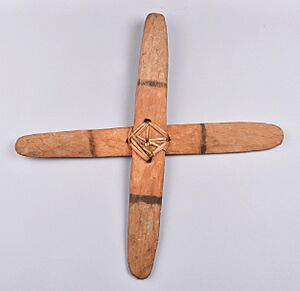
A boomerang is a throwing stick with special aerodynamic properties. It is usually made of wood. A "classic" boomerang flies in a circle or teardrop shape and returns to the thrower. Its range can be from 3–60 m (9.8–196.9 ft). Hunting boomerangs, which do not return, fly in a straight line. They usually go 40–90 m (130–300 ft). There are also long-range boomerangs that fly in an S-shape. Wind affects how all types of boomerangs fly.
A returning boomerang acts like a spinning wing. It has two or more arms, or wings, joined at an angle. Each wing is shaped like an airfoil. Boomerangs can be made for right-handed or left-handed throwers. The difference is small. A right-handed boomerang flies in a counter-clockwise circle to the left. A left-handed boomerang flies clockwise to the right. Most sport boomerangs weigh between 70 and 110 g (2.5 and 3.9 oz). They have a wingspan of 250–300 mm (9.8–11.8 in) and a range of 20–40 m (66–131 ft).
When a boomerang is thrown with a lot of spin, it flies in a curve instead of a straight line. If thrown correctly, it returns to where it started. As the wings spin and the boomerang moves, air flowing over the wings creates lift. One side of each blade moves faster through the air than the other. This is because the spinning speed adds to the forward speed on one side. On the other side, the spinning speed subtracts from the forward speed. So, if thrown almost upright, the top part of each blade creates more lift than the bottom. This difference in lift, combined with the boomerang's spinning motion (called gyroscopic precession), makes it turn. If thrown flat, like a Frisbee, the same effect would make it fly straight up and then crash.
"Fast Catch" boomerangs usually have three or more wings that look the same from above. "Long Distance" boomerangs often look like a question mark. "Maximum Time Aloft" boomerangs usually have one wing much longer than the others. This design helps them "auto-rotate" to stay in the air longer.
Some boomerangs have small bumps or pits on their top surface. These are called turbulators. They help increase lift by making the airflow stick better to the surface.
In 1992, German astronaut Ulf Merbold tested a boomerang in space. He found that boomerangs work the same in zero gravity as they do on Earth. French astronaut Jean-François Clervoy repeated this in 1997. In 2008, Japanese astronaut Takao Doi did the experiment again on the International Space Station.
How to Throw a Boomerang
Boomerangs should be thrown in open areas. The space should be at least twice as big as the boomerang's range. The boomerang's design decides if it flies left or right, not the thrower. You can throw a right-handed boomerang with either hand. But throwing it with your non-dominant hand might feel awkward. The tips below are for a right-handed boomerang. For a left-handed one, just reverse the directions. Different boomerangs fly differently. The accuracy of your throw depends on understanding your boomerang. It also depends on the wind's strength and direction. You need to choose the right angle, elevation, spin, and throwing force. It takes a lot of practice to throw perfectly.
A well-thrown boomerang will fly parallel to the ground. It might climb a little. Then it will make a smooth, counter-clockwise circle or teardrop shape. It will flatten out and return, hovering. It will come in from the left or spiral in from behind. Ideally, it will hover so you can catch it easily. You can sandwich the center of the boomerang between your hands.
The way you hold it depends on its size and shape. Smaller boomerangs are held between a finger and thumb at one end. Larger or heavier ones need one or two fingers wrapped over the top edge to make them spin. The wing-shaped side must face towards you. The flatter side faces outwards. It should be tilted outwards, from almost straight up to 20° or 30°. The stronger the wind, the more upright it should be. The boomerang's "elbow" can point forward or backward. It just needs to start spinning at the right angle and with the right force.
Aim the boomerang to the right of the wind coming towards you. The exact angle depends on the wind and the boomerang. Left-handed boomerangs are thrown to the left of the wind. They will fly clockwise. The flight path should be parallel to the ground or slightly upwards. A boomerang can return even without wind. But even very light winds must be considered. Little or no wind is best for an accurate throw. Light winds (up to 3–5 knots (6–9 km/h; 3–6 mph)) can be managed with skill. If the wind is strong enough to fly a kite, it might be too strong. Unless you are a skilled thrower with a boomerang made for strong winds. Gusty days are challenging. You need to watch the wind and throw during calm moments.
Boomerang Competitions and Records
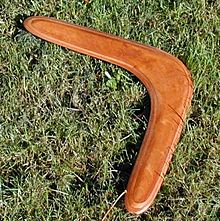
An aerodynamic returning boomerang.
|
|
| First played | Ancient |
|---|---|
| Characteristics | |
| Contact | No |
| Mixed-sex | No |
| Type | Throwing sport |
| Equipment | Boomerang |
| Presence | |
| Country or region | Australia |
| Olympic | No |
| World Games | 1989 (invitational) |
On June 3, 2007, Tim Lendrum set a world record in the "Aussie Round." He scored 96 out of 100 points. This was a national record and tied the world record. He used an "AYR" boomerang made by Adam Carroll.
In international competitions, a world cup is held every two years. As of 2017, teams from Germany and the United States were very strong. Manuel Schütz from Switzerland won the individual World Champion title in 2000, 2002, 2004, 2012, and 2016. Fridolin Frost from Germany won in 1992, 1998, 2006, and 2008.
The team competitions in 2012 and 2014 were won by "Boomergang." This was a team with people from different countries. Germany won the team world championship in 2012. Japan won for the first time in 2014. In 2016, the USA became team world champion.
Competition Events
Modern boomerang tournaments usually have some or all of these events. In all events, the boomerang must fly at least 20 metres (66 ft) from the thrower. Throwing is done individually. The thrower stands in the middle of circles marked on an open field.
Events include:
- Aussie Round: Many people think this is the hardest test of boomerang skills. The boomerang should ideally cross the 50-metre (160 ft) circle and come back to the center. Each thrower gets five tries. Points are given for distance, accuracy, and the catch.
- Accuracy: Points are given based on how close the boomerang lands to the center. The thrower cannot touch the boomerang after throwing it. Each thrower gets five tries. In big competitions, there are two accuracy events: Accuracy 100 and Accuracy 50.
- Endurance: Points are given for how many times you can catch the boomerang in 5 minutes.
- Fast Catch: This measures how quickly you can throw and catch the boomerang five times. The fastest time wins.
- Trick Catch/Doubling: Points are given for special catches. These include catching behind your back or between your feet. In Doubling, you throw two boomerangs at the same time. Then you catch them one after another in a special way.
- Consecutive Catch: Points are given for how many times you can catch the boomerang without dropping it. This event is not timed.
- MTA 100 (Maximal Time Aloft, 100 metres (328 ft)): Points are given for how long the boomerang stays in the air. The field is usually a 100 m circle. An alternative, "MTA unlimited," has no distance limit.
- Long Distance: The boomerang is thrown from the middle of a 40-metre (130 ft) starting line. The furthest distance the boomerang travels away from this line is measured. When it returns, it must cross the starting line again. It does not have to be caught.
- Juggling: This is like Consecutive Catch, but with two boomerangs. One boomerang must always be in the air.
World Records
| Event | Result | Name | Year | Tournament |
|---|---|---|---|---|
| Accuracy 100 | 99 points | 2007 | ||
| Aussie Round | 99 points | 2007 | ||
| Endurance | 81 catches | 2005 | ||
| Fast Catch | 14.07 s | 2017 | ||
| Trick Catch/Doubling | 533 points | 2009 | ||
| Consecutive Catch | 2251 catches | 2009 | ||
| MTA 100 | 139.10 s | 2010 | ||
| MTA unlimited | 380.59 s | 2010 | ||
| Long Distance | 238 m | 1999 |
Guinness World Records
Smallest Returning Boomerang
Sadir Kattan from Australia holds the record for the Smallest Returning Boomerang. In 1997, he made one that was 48 mm (1.9 in) long and 46 mm (1.8 in) wide. This tiny boomerang flew the required 20 m (66 ft) and returned. This happened on March 22, 1997, at the Australian National Championships.
Longest Throw of Any Object by a Human
A boomerang was used to set a Guinness World Record for the longest throw. David Schummy threw a boomerang 427.2 m (1,402 ft) (about 1,401 feet). This happened on March 15, 2005, in Australia. This broke the previous record set by Erin Hemmings. He threw an Aerobie 406.3 m (1,333 ft) in 2003.
Related Words
In the Noongar language, a kylie is a flat, curved piece of wood. It looks like a boomerang. It is thrown when hunting birds and animals. "Kylie" is one of the Aboriginal words for a hunting stick. These sticks were used in fighting and for hunting. Kylies fly in straight lines, not curves. They are usually much bigger than boomerangs. They can travel very far. Because of their size and hook shapes, they can seriously hurt an animal or person. The word "kylie" might be an English version of an Aboriginal word for "boomerang." For example, the Warlpiri word "karli."
See also
 In Spanish: Búmeran para niños
In Spanish: Búmeran para niños
- List of premodern combat weapons
- List of martial arts weapons
- Australian Aboriginal artefacts
- Cateia, an ancient Egyptian throwing weapon
- Chakram, an Indian throwing weapon
- Throwing stick, used in Australia
- Valari, an Indian throwing weapon


